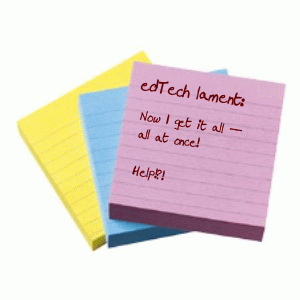A recent eSchoolNews article about dueling copyright curricula couldn’t have surfaced at a more opportune time, seeing as how I literally just days before had utilized some materials from one of the curriculums in question.
On the one hand, the Copyright Alliance Education Foundation (CAEF) recently published Think First, Copy Later, seen by some as slanted toward the interests of copyright owners.
On the other hand, the Electronic Frontier Foundation (EFF), unveiled Teaching Copyright. The EFF is characterized as an advocacy group that serves the interests of users and consumers of digital media.
Admittedly, I was not aware of the CAEF curriculum when I recently selected and distributed some of the EFF’s support documents to a group of pre-service teachers at the University of Tennessee-Knoxville. But I am inspired by the prospect of having access to and using “dueling curricula,” if and when I teach about copyright again in the future.
What an opportunity for teachers to exercise professional discernment! What an opportunity for students to see copyright law presented from two different perspectives — owner versus user, industry versus consumer! What an opportunity to engage higher-order thinking and some good, old media literacy skills, such as evaluating audience, authorship, message, and meaning!
Teachers need these resources now more than ever. It was not too long ago that teacher training on the vagaries of fair use doctrine were conducted in the faculty workroom, usually between classes, as we waited in line at the photocopier. We traded in stories, myths, and half-truths and competed for bragging rights to the title of “Greatest Copyright Infringer.” We made half-joking references to a sinister, Gestapo-like “Copyright Police” waiting in the wings. (I know. I was one of those teachers.)
The surge of web-based information and communication technologies makes it easier than ever to facilitate content creation and sharing in our classrooms, but we must first be equipped to engage students in conversation about content creation that is safe, ethical, and legal.
The alternative is to do nothing for fear of violating the law. This phenomenon was documented by Hobbs, Jaszi, and Aufderheide in their 2007 report for the Center for Social Media, The Cost of Copyright Confusion for Media Literacy. In 2008 the Center published the Code of Best Practices in Fair Use for Media Literacy Education, which states that fear and confusion about copyright:
detracts from the quality of teaching. Lack of clarity reduces learning and limits the ability to use digital tools. Some educators close their classroom doors and hide what they fear is infringement; others hyper-comply with imagined rules that are far stricter than the law requires, limiting the effectiveness of their teaching and their students’ learning.
Check out the accompanying video:












